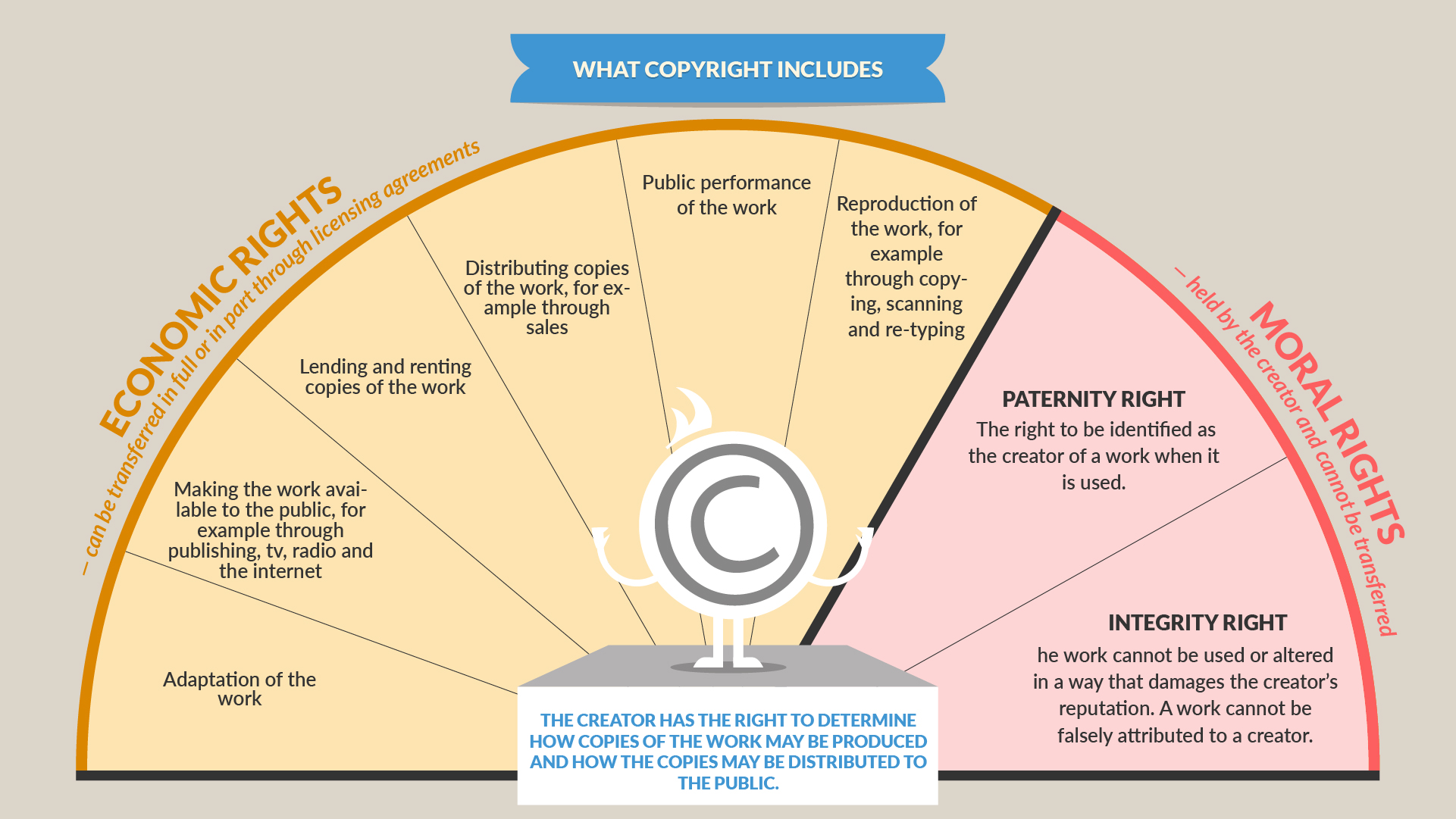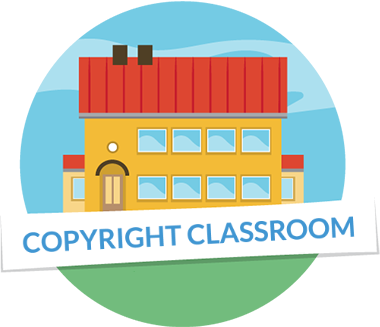The rights of the copyright owner
Copyright consists of two types of rights: economic rights and moral rights.
Economic rights: The author or creator of a work has the exclusive right to decide whether copies of their work can be made and whether the work can be made available to the public and whether it should be made available for free or for a fee. They also have the right to determine if their work can be altered, translated into another language, adapted to a different literary genre or art form, or performed in any other way.
Moral rights: These are the rights a creator has to be identified as the creator of a work, for their work to be attributed to them, and for their work not to be altered and then to be falsely attributed to them in altered form with a possible risk to their reputation.
In other words, if you want to use a work that someone else has created, in its original form or in a modified form, you require the permission of the creator and you must attribute the work to its creator using wording the creator chooses. In the case of a collaborative work created by multiple individuals, the permission of all rightsholders is required to use the work.
Who is the creator?
The ‘creator’ is the person who has created the work. A work can, for example, be created by an author, a composer, a lyricist, an artist, a director, a scriptwriter, a photographer, a cinematographer, an editor, etc. A creator is always a human being. The age of the creator does not matter; even a minor (under 18 years old) enjoys copyright protection for their works.
If two or more people create a work together, it is considered a joint work, and the copyright belongs to them jointly. In joint works, the personal contributions of the creators are not independent works, which means that the permission of all creators is required to use a joint work.
Is the ‘copyright holder’ always the creator?
A creator can assign their economic rights, in whole or in part, to someone else, such as a publisher, producer, or employer. The person to whom copyright is assigned, becomes the copyright holder.
The creator’s moral rights to be identified as the creator and not to be misrepresented are inalienable, meaning they cannot be assigned to anyone else.
The copyright holder is the individual or organisation that holds the rights according to copyright law. The copyright holder can be the original creator of the work or a person or organisation to whom/which the creator has assigned their copyright, in whole or in part. Examples of copyright holders are publishers, and film and sound producers.
The transfer of copyright can be agreed upon in publishing agreements, record contracts, film agreements, employment contracts, collective licences, and so on.
Rights transfer is often negotiated in user rights or licensing agreements, where specific usage rights are granted, such as the right to use electronic educational materials or to record an audiobook. The recipient of user rights in such cases does not become the copyright holder but simply the licensee of the copyright holder.
Ownership of a physical copy of a work, such as a printed book, a film recording, or a painting, does not grant the owner copyright in the work.
[CRRA Sec. 3 and 21]
What rights does the creator have?

Economic rights
Economic rights include the exclusive right to determine:
- The reproduction of a work – that is, copying by any means including photocopying, scanning and re-typing, to create printed or digital copies.
- Making the work available to the public in an unchanged or modified form, such as translation or adaptation, into another literary or artistic genre, or by using another method of presentation.
The reproduction of a work includes all types of copying including scanning, photocopying, or any other form of duplication and/or storing a work in digital form.
It is also the exclusive right of the creator to control the copying of their work in a modified form.
The right to determine the copying of works also applies to parts of the work. Even copying a verse from a poem or a portion of an article requires the creator’s permission. There is, however, an exception for news reporting, criticism/literary critique and parody.
A work is made available to the public when, for example, a composition is performed at a concert, a film is shown in a cinema, a photo is posted on a website, or a book is published and offered for sale in a bookshop. A work can be made available to the public through means such as a data network, public performance, or display, or by selling or offering access to the work in return for a subscription.
[CRRA Sec. 37-43]
Moral rights
Moral rights consist of two main elements: the right of paternity and the right of integrity.
The right of paternity means that the creator has the right to be named as the creator of the work when it is used. The name should be provided when copies of the work are produced or when the work is made available to the public, for example, by displaying it publicly. There are no detailed regulations on how and where the name should be provided. The name should be given in the context where it is natural to do so on each occasion.
The right of integrity means that the work cannot be altered without the creator’s permission and that an altered version of a work cannot be attributed to the original creator, who might suffer reputational damage as a result.
[CRRA Sec. 107-119]
Limitations to copyright
In general, a creator has the exclusive right to decide how their work is used. However, there are several exceptions in the Copyright Act to the creator’s exclusive rights, known as limitations and exceptions in copyright. These exceptions allow a work to be used without the creator’s permission.
The most common copyright exceptions apply to copying for the purposes of research and private study. There are also exceptions for news reporting, quotation for literary criticism, review, and parody. This bundle of exceptions is known as ‘fair dealing’.
The Copyright Act also includes various provisions for copying for educational purposes; these include copying for use in an examination paper and copying an extract of no more than 5% of a book for a particular course of study. In Ireland, all schools, colleges and universities make use of these educational exceptions under the relevant ICLA licence.
There are also exceptions for making copies available for anybody with visual, physical or cognitive disabilities as required by EU Regulation (EU) 2017/1563 and Irish legislation [CRRA Sec. 104].
Even when copyright exceptions are applied, the creator’s moral rights continue to apply and should be respected. This means crediting the creator and the source and not making any alterations. The Copyright Act also requires that the work copied is legally available to the user.
